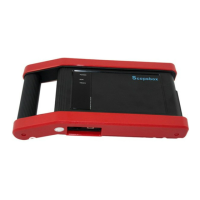
Do you have a question about the Launch X431 Scopebox and is the answer not in the manual?
| Input Voltage | 12V DC |
|---|---|
| Channels | 4 |
| Sampling Rate | 1GSa/s |
| Vertical Resolution | 8-bit |
| Input Impedance | 1 MΩ |
| Voltage Range | ±40V |
| Connectivity | Bluetooth, USB |
| Operating System | Android |
| Processor | Quad-core |
| Supported Protocols | CAN, LIN, FlexRay |
Overview of the X-431 PAD Scopebox and its capabilities.
Highlights key functionalities like rapid signal capture and waveform storage.
Describes the specialized automotive oscilloscope and ignition waveform analysis functions.
Details the specifications such as channels, sampling frequency, and resolution.
Diagram and description of the physical components and ports of the Scopebox.
Lists and describes the various accessories included with the Scopebox.
Instructions on how to connect the Scopebox to the main unit and power supply.
Overview of the initial screen layout and graphical elements of the oscilloscope.
Detailed procedures for using the oscilloscope functions.
How to select channels and adjust their display and measurement attributes.
Configuration of trigger modes, sources, and slopes for waveform capture.
Process for calibrating the oscilloscope's vertical and horizontal systems.
Options for adjusting waveform display type (vectors/dots) and grid visibility.
Methods for measuring signals using channels and cursors for analysis.
Features for recording, saving, and managing waveform data.
How to check the current software version of the oscilloscope.
Procedure to properly close the oscilloscope application.
Detailed steps for analyzing secondary-distributor ignition waveforms.
Procedure for analyzing secondary-simultaneous ignition waveforms.
Steps for analyzing secondary-direct ignition waveforms.
Explains the main uses of single-cylinder waveform testing for engine diagnostics.
